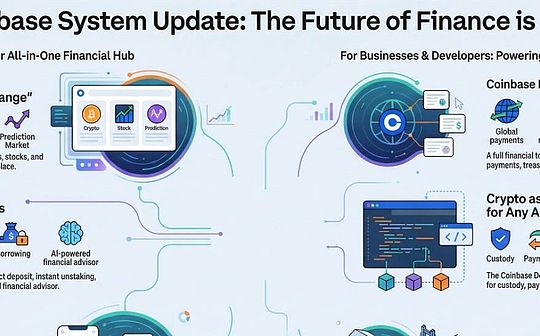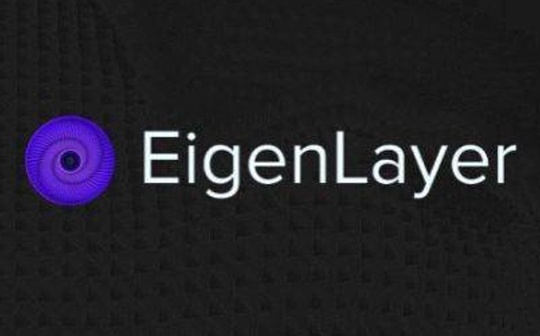
Author: Goplus
background
From last year to today, Eigenlayer, as a large core narrative in the Ethereum ecosystem, has accumulated more than 10 billion US dollars TVL. However, most people may simply regard it as a financial infrastructure, mainly because Eigenlayer is the most.Wide -known characteristic is its “RESTAKING” concept.This preliminary impression is easy to make people think that Eigenlayer is just a platform to help users get additional pledge income.In fact, when we think deeply, a key question emerges: Why can the ETH or LST (liquid pledged tokens) pledged in the pledged pledged income?The answer to this question reveals the true essence of Eigenlayer.I think Eigenlayer is actually a revolutionary financial -driven cloud computing infrastructure.This definition may be a bit contradictory at first glance, but it just reflects the innovation of Eigenlayer.Traditional cloud computing services, such as AWS or GCP, mainly rely on centralized resource allocation and management to provide computing power.Eigenlayer created a new cloud computing infrastructure model by cleverly combining financial incentive mechanisms and distributed computing resources.This article will go deep into EIGENLAYER’s principles and mechanisms according to our understanding. After several months of development practice, we will also share some experience and ideas of how to create their own decentralized networks based on EIGENLAYER to create their own decentralized networks, how to design AVSEssence
What is Eigenlayer?
First of all, Eigenlayer is a revolutionary Ethereum ecosystem infrastructure.For users, it can allow users who hold Ethereum assets not only to obtain interest through pledge, but also use these deposit vouchers to support other potential projects and earn additional rewards.This is the core concept of Eigenlayer -RESTAKING.It is like a magical bridge that connects the strong security of Ethereum and all projects that need network consensus security.For developers, it is like a cloud computing platform that provides security guarantees, allowing them to focus on building decentralized services itself without having to build complex consensus and security systems from scratch.
>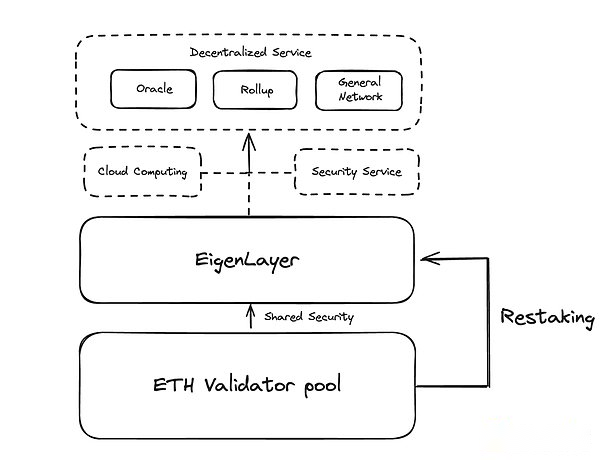
What is AVS and how to operate?
Based on Eigenlayer, developers can build their ownActively Validated Service (AVS)This is also the most important concept of Eigenlayer ecosystem. AVS simply is to be a protocol, service or system that needs to be mortgaged to verify the “task”.For example, if you want to build a decentralized price prophet network, in order to prevent the participation nodes of the prophet network doing evil, you need to mortgage a certain asset of these nodes, and set the node when each node reports the price on the broadcast price when the price is reported to the priceThe consensus mechanism, then this kind of scene is very suitable for completing AVS. The AVS service itself undertakes the work of acquiring prices and reporting prices. At the same time, AVS also corresponds to its service management contract -Service Manager.It includes a state -related state, such as operators running services and the number of deposits for protecting services.According to Vyas Krishnan, Eigenlayer undertakes the role of “Convert Crypto to Cloud”, then AVS is the Cloud Service we are familiar with Web2, and the ability to calculate the Crypto pure chain into a cloud computing under the link.So how does AVS work on the EigenLayer network?
>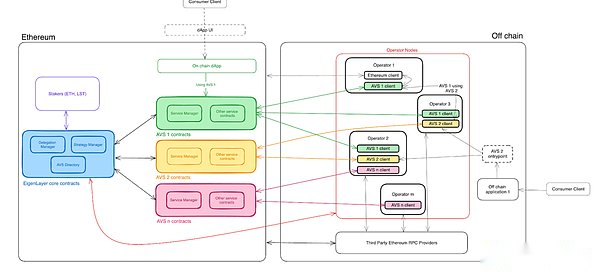
-
First of all, as a project party who wants to use the Eigenlayer network, you need to develop your own AVS client and the ServiceManager contract. The client itself is the service or system that the network will verify.And the ServiceManager contract itself stipulates the conditions for nodes to participate in the network and the mechanism for rewards and punishments of the node itself.Such as: which tokens need to be mortgaged, and the minimum tokens that need to be mortgaged.At the same time, it is necessary to follow some specifications of the AVS ServiceManager contract to retain some basic interfaces to index and communicate by the EIGENLAYER main contract.
-
The participation node of the network itself is called ** “operator” ** in Eigenlayer,OperatorIt is a professional node operator, which is mainly responsible for actual operation and maintenance of network nodes. When they want to participate in a network, they need to meet the access conditions specified in the ServiceManager.As an operator, they can also be a node for staker to pledge to themselves.So, how does ordinary users participate in the entire workflow process? Eigenlayer designed a delegate function. It allows ordinary usersNetwork income.
-
After completing the construction of AVS and the recruitment of nodes, the service of the network can be opened to be consumed and used. The figure below is a schematic diagram of the entire AVS service call process given by the official
-
High start cost: The project party needs to invest a lot of funds and manpower to attract nodes to join the network.
-
Operating pressure: Maintaining an active node network requires continuous operation and incentive measures.
-
High threshold for node participation: Potential node operators need to purchase tokens from specific networks to participate, increasing their risks and costs.
-
Slow network effect: Due to the few participants, the new network is difficult to quickly establish security and reliability.
-
Calculating dense services requires high -performance server
-
Storage dense services require large -capacity storage
-
Financial services may require stricter security measures and higher punishment
-
Content distribution services may be more concerned about tampering and usability
-
Real -time chain risk control services require extremely low delay
-
AI services require a lot of GPU computing power performance
-
The prediction machine service may need to verify the consistency of multiple data sources
-
DA service needs to verify the storage and retrieval of data
-
The risk control on the chain needs to simulate and review the transaction, and the real -time efficiency and accuracy requires real -time efficiency and accuracy
-
What behavior defines is regarded as “evil”
-
Setting appropriate punishment strength is not only enough to deter, but not too severe, resulting in a decline in node participation
-
Fair design and transparent judgment and execution mechanism
-
The profit model and expected income of the service, or how to combine with its own tokenomics in the early stage of the project to give enough rewards to the expected expected expected
-
Operating costs, including infrastructure, maintenance, etc.
-
The reward budget for nodes and pledges can be distributed to nodes and pledges
-
Small networks may be easier to manage, but may sacrifice some degree of decentralization
-
Larger networks may provide higher security, but may increase complexity and cost
-
DA
-
Decentralized Sequenceer
-
Random number
-
ZK-Prover
-
Prediction machine service
-
Lack of traditional universal decentralization computing network
-
There are almost no avs that provides services directly to the end users
-
Wallet address risk assessment
-
Anti -fishing and anti -fraud protection
-
Token risk assessment
-
Decentralized real -time chain on the firewall
>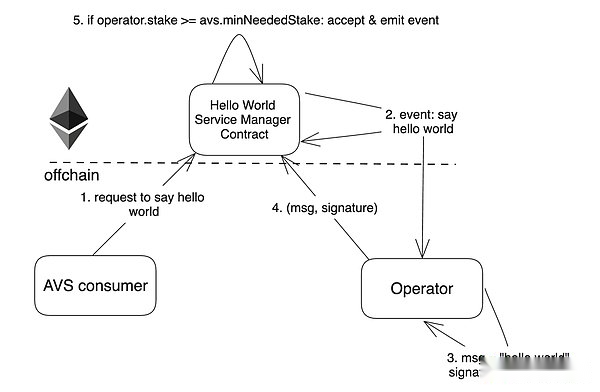
It can be seen that the Service Manager triggered the operator node through the Event event to perform the calculation under the chain. Operation will return the calculation result to the contract through the private key signature to complete the call.But in fact, the usage of AVS can be more flexible. First of all, triggering AVS does not have to be performed through the service manager. Since the Operator node has released their IP and other gateway information when registering, the gateway exposure can be called directly to the gateway exposureThe service interface (required authority to prevent a large number of spums from obtaining a large number of spums), but in the process, the results of the report need to be reported and the results are completed through Aggregator, because the same call may run the corresponding service by multiple nodes to run the corresponding service.To improve the availability of the service.In the end, the Service Manager completed the reward and punishment of nodes with the EIGENLAYER contract based on the results of the report.
Eigenlayer’s core positioning
After talking about the introduction of AVS and Eigenlayer, I would like to summarize the main three -point core positioning of Eigenlayer to make it easier for everyone to better understand it and judge whether to use it.
The platform of link mortgagers and developers
One of EIGENLAYER’s core positioning is a platform to connect pledges and developers.This innovation model has completely changed the construction and participation of decentralized networks, bringing unprecedented opportunities and convenience to both parties.Before Eigenlayer appeared, the new decentralized network faced a huge cold start challenge:
Eigenlayer cleverly solves these problems through its innovative design.It allows pledges to use ETH or LST to provide node services to multiple networks at the same time, which greatly reduces the participation threshold.The project party can quickly access a huge pledged network to accelerate the starting process.For node operators, they no longer need to purchase specific token for each participating online, which reduces risk exposure.By allowing pledges to receive rewards from multiple networks, Eigenlayer has created a win -win ecosystem and achieved effective alignment of incentives.This innovation model not only simplifies the construction and participation of the decentralized network, but also provides a effective scene for most tokens.
From the current Eigenlayer ecosystem, we can find that there are already a large number of very good endors of Operator nodes, including Coinbase Cloud, Figment, Google Cloud, Galaxy, Hashkey, etc.The addition of these institutions not only brings professionalism and reliability to the ecosystem, but also greatly enhances the confidence of ordinary users.DELEGATOR can choose these powerful Operations to entrust their own assets, which not only obtains professional node operation services, but also reduces risks.For developers, such convenience is self -evident. They can quickly build their own verification network from scratch, reduce the cost of development consensus network and maintenance, and use the mature large -scale pledged pond pools to so as to be used so asGet a relatively high level of security, put the focus more on your own product and service innovation, rather than repeating the wheel of consensus infrastructure.
Sharing safety pool
The largest feature of Eigenlayer mentioned above is that it is possible to connect the node of the pledged and developers and help the project to quickly find the service of the service. For developers and projects, how to ensure the stability of these nodes and achieve the security of their own networks.What about sex?This is one of the core issues solved by Eigenlayer, and it can also be said to be the biggest selling point of Eigenlayer.
Here we must first define what the so -called network security is. We all know that in the traditional blockchain and decentralized network architecture, each network needs to independently build and maintain its own security and consensus system.Because in a distributed system, each node is likely to do evil, so the network must be based on a zero -trust appointment, and it is necessary to build a meticulous consensus mechanism to prevent nodes from doing evil to maintain the stability of the networkAnd security.Generally speaking, most networks will choose to allow nodes to pledge their own network tokens as mortgages to allow nodes to participate in the work of the network to obtain income. Through ** “Slash” **Cost, thereby achieving the goal.But the cost here may not be stable, that is, if the mortgage itself is the native token of these networks, the cost of nodes is constantly fluctuating with the fluctuation of the price.When the cost “is the condition, this network will be in a security crisis. This situation has also occurred many times in history, and most of the price of online native currencies is really easy to be controlled and unstable.
In the solution given by Eigenlayer, it focuses on the concept of sharing security. In fact, the security of Ethereum is rented to these decentralized networks in the form of benefits.By allowing mortgagers, nodes, and various items, the mortgage that determines the cost of evil turned into ETH/LST. Due to the stability of ETH and the pledge of token prices, this network security is actually more trustworthy.This can also help a network quickly establish a stable and secure decentralized service network in the early days, and use its own token as the income to pay the “security service fee” of the entire network.Similarly, it can also help the original centralized service in this way to a centralized transition, thereby improving the quality and transparency of the original service, and then from the gains obtained due to service improvement, to take out a part of the income to these shared safetyThe pledges reward and enter a positive cycle.
At present, EIGENLAYER has a TVL assets close to 12B US dollars, which is equivalent to a huge shared security pool, which is enough to provide various DA, Sequence, prophecy machines, and various decentralized network security services.
Programmable consensus
Eigenlayer’s third core advantage is its ability to programming consensus.Here you need to introduce the concept of AVS. AVS’s full name Actively Validated Services. AVS refersCorrespondingOperatorTo operate, it is finally managed and consensus to manage and maintain consensus.Operator needs to be registered through the contract entrance, and the reward and punishment will also be triggered by the contract, so it can be said that the contract is used as a consensus gateway for AVS.When developers write contracts, they can flexibly define their own AVS verification rules and requirements, node access rules, SLASH rules, etc., and even flexible allocation of pledged tokens.Eigenlayer’s programmable consensus capabilities provide developers with unprecedented flexibility and innovative space.Through this feature, developers can dynamically adjust consensus parameters according to the development stage and needs of the network to ensure that the network can maintain the best performance and security in different scenarios.This adaptability allows the project to optimize its operating mechanism at any time and cope with the changing market environment and user needs.
AVS’s design ideas and principles
Before designing my own AVS, I think most developers need to think about the following issues:
1. The service requirements and types provided by the project itself
Understand the service type provided by the project is the basis of designing AVS, because it directly affects:
necessity: Calculate whether the VM on the chain cannot be executed or the cost is too high. If it is a contract on the chain, you can complete the verification, then you can consider the necessity of using AVS
Verification logic: Different services require different verification methods.For example:
Performance: The service type determines the requirements for speed and throughput.like:
Security model: Different services face different security threats and affect the design of punishment mechanisms.For example:
Node requirements: The service type determines the hardware and software requirements of the node.like:
2. How to punish nodes of evil
This problem is directly related to the security and reliability of AVS.Developers need to design an effective punishment mechanism to maintain the security and stability of the network.This includes:
A reasonable punishment mechanism can effectively reduce the motivation of nodes to do evil and ensure the long -term healthy operation of the network.
3. The profitability of the service itself and the budget that can be paid to “shared security”
This problem involves AVS’s economic sustainability.Developers need to evaluate:
A reasonable economic model can ensure that AVS can attract and retain sufficient nodes and pledges, while maintaining sustainable development of the project.
4. How much network scale is needed
The scale of the network directly affects the performance, decentralization and security of AVS:
Developers need to find the best balance point according to service needs and resource constraints.
Only by clearing these issues, I think it is possible to design a good and highly involved AVS, and to avoid major problems that may occur in the later period due to insufficient thinking.
Avs currently ecological and new opportunities
Although Eigenlayer is still in the early stage, we believe that the ecology has a lot of opportunities and potential.First of all, observe according to us,
The current AVS in ecology is mainly concentrated in the following areas:
>
These services are mainly facing developers and provide key support for blockchain infrastructure.However, we noticed that there are some significant gaps in the ecology:
We believe that a large number of application AVS can bring more possibilities to the ecology.These application AVS can directly serve end users, thereby expanding the influence and practicality of Eigenlayer.As a provider of user security services, Goplus is using Eigenlayer’s infrastructure to build an AVS focusing on user security.This AVS will provide comprehensive security protection services for cryptocurrency users, including but not limited to:
Goplus will provide decentralized, transparent and reliable security services by constructing AVS on Eigenlayer.This measure not only enhances the credibility of the service, but also attracts more participants through the incentive mechanism.Goplus’s AVS will provide users with better protection, while helping EIGENLAYER to expand to new applications facing end users. At present, the average daily demand of Goplus’s security services is as high as 21 million times.The largest application type in the ecology.And providing security services in a decentralized manner, which is also a new security paradigm in the development of the web3.


